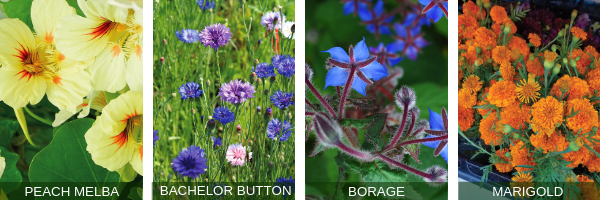Small scale flower growing is on the rise with many dedicated flower farmers paving the way for locally sourced flowers at farmer’s markets, wholesale markets, boutiques, weddings and even flower-only CSA boxes. This past winter Linda, a customer service sales representative here at Osborne Quality Seeds, was invited to the Pacific Northwest Cut Flower Grower’s Meetup in Corvallis, Oregon. On this trip, she met micro-scale flower farmers on 1/3rd acre or less, established names in the business and networked with individuals that were primarily vegetable farmers but also grew flowers.
Below are some simple insights for those just getting their hands into the flower growing business and looking to add flowers into their vegetable farms.
.png?width=600&name=Untitled%20design%20(13).png)
Start easy
Some flowers have very particular germination and growing needs that are more challenging for beginner-level-growers. Even very seasoned flower farmers sometimes buy starts that are varieties that can be more difficult to grow. Easier varieties to start growing with would be sweet peas, sunflowers, zinnias, rudbeckia, marigolds, nigella, strawflowers and gomphrena.
Mixes or single colors
Many flower farmers that are selling to florists or wholesale markets like to grow in monochromatic colors. They do this to provide diversity and control over bouquets and to be able to sell full buckets of each color to their customers.
Many farmers have u-pick stands or sell at a farmer’s market and enjoy the ease and color combinations in mixes. Growers can customize mixes by buying more of the colors that their customers prefer, such as brighter varieties versus subdued hues usually found in weddings and floral boutiques, and adding them into their arrangements.
Successions
Just like with vegetables, you can plant successions every few weeks to create a continuous bloom depending on how long the harvest window is for each variety.
Zinnias: can be planted 3 times per season or about every four weeks and have high yields.
Sunflowers: can be direct seeded every three weeks.
Marigolds: can be seeded every three weeks and harvested 2 times per week.
Many farmers will direct seed sunflowers, strawflowers, nigella, marigolds and zinnias for succession growing after last frost. For earlier plantings, farmers will transplant after the last frost to get a jump start on the season; Transplanting provides more overall control for planting and spacing.
Adding veggies
Vegetables can liven up your flower selections as well including ornamental peppers and flowering kale which are common to find in bouquets. Herbs are also serve as a dual purpose and can be used in bouquets to add fragrance and a unique touch; Varieties such as fennel, flowering basil, dill, oregano and lavender are herbs that are often found in bouquets which are a nice way to use some vegetable crops that are past a harvest-able point for food consumption.
Edible Flowers
Chefs and market-goers are more and more interested in edible flowers and are generally sold in clam-shells or bags as whole flowers without stems. We have added some exciting edible flowers to our seed selection this year that can be grown for mixed clam-shells or single flower arrangements.

The above images are all edible varieties.
Check out our selection of nasturtiums, borage, marigolds, bachelor’s buttons and all other flower varieties we carry by clicking here. Be sure to keep an eye out for our ‘edible flower’ icon for our recommendations in our catalog.